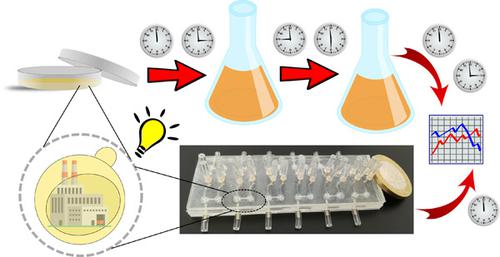当前位置:
X-MOL 学术
›
Biotechnol. Bioeng.
›
论文详情
Our official English website, www.x-mol.net, welcomes your feedback! (Note: you will need to create a separate account there.)
Downscaling screening cultures in a multifunctional bioreactor array-on-a-chip for speeding up optimization of yeast-based lactic acid bioproduction.
Biotechnology and Bioengineering ( IF 3.8 ) Pub Date : 2020-03-19 , DOI: 10.1002/bit.27338 Damiano Totaro,Mario Rothbauer,Matthias G Steiger,Torsten Mayr,Hsiang-Yu Wang,Yu-Sheng Lin,Michael Sauer,Martin Altvater,Peter Ertl,Diethard Mattanovich
Biotechnology and Bioengineering ( IF 3.8 ) Pub Date : 2020-03-19 , DOI: 10.1002/bit.27338 Damiano Totaro,Mario Rothbauer,Matthias G Steiger,Torsten Mayr,Hsiang-Yu Wang,Yu-Sheng Lin,Michael Sauer,Martin Altvater,Peter Ertl,Diethard Mattanovich

|
A key challenge for bioprocess engineering is the identification of the optimum process conditions for the production of biochemical and biopharmaceutical compounds using prokaryotic as well as eukaryotic cell factories. Shake flasks and bench‐scale bioreactor systems are still the golden standard in the early stage of bioprocess development, though they are known to be expensive, time‐consuming, and labor‐intensive as well as lacking the throughput for efficient production optimizations. To bridge the technological gap between bioprocess optimization and upscaling, we have developed a microfluidic bioreactor array to reduce time and costs, and to increase throughput compared with traditional lab‐scale culture strategies. We present a multifunctional microfluidic device containing 12 individual bioreactors (V t = 15 µl) in a 26 mm × 76 mm area with in‐line biosensing of dissolved oxygen and biomass concentration. Following initial device characterization, the bioreactor lab‐on‐a‐chip was used in a proof‐of‐principle study to identify the most productive cell line for lactic acid production out of two engineered yeast strains, evaluating whether it could reduce the time needed for collecting meaningful data compared with shake flasks cultures. Results of the study showed significant difference in the strains' productivity within 3 hr of operation exhibiting a 4‐ to 6‐fold higher lactic acid production, thus pointing at the potential of microfluidic technology as effective screening tool for fast and parallelizable industrial bioprocess development.
中文翻译:

在多功能生物反应器芯片阵列中缩小筛选培养物,以加速基于酵母的乳酸生物生产的优化。
生物过程工程的一个关键挑战是确定使用原核和真核细胞工厂生产生化和生物制药化合物的最佳工艺条件。摇瓶和实验室规模的生物反应器系统仍然是生物工艺开发早期阶段的黄金标准,尽管众所周知,它们昂贵、耗时、劳动密集,并且缺乏高效生产优化的吞吐量。为了弥合生物过程优化和升级之间的技术差距,我们开发了一种微流体生物反应器阵列,以减少时间和成本,并与传统的实验室规模培养策略相比提高产量。我们提出了一种多功能微流体装置,其中包含 12 个独立的生物反应器 ( Vt = 15 µl) 在 26 mm × 76 mm 的区域中,具有溶解氧和生物量浓度的在线生物传感。在初步设备表征之后,生物反应器芯片实验室被用于原理验证研究,以从两种工程酵母菌株中鉴定出最具生产力的乳酸生产细胞系,评估它是否可以减少所需的时间用于收集与摇瓶培养相比有意义的数据。研究结果表明,运行 3 小时内菌株的生产力存在显着差异,乳酸产量高出 4 到 6 倍,从而表明微流体技术作为快速和可并行工业生物过程开发的有效筛选工具的潜力。
更新日期:2020-03-19
中文翻译:

在多功能生物反应器芯片阵列中缩小筛选培养物,以加速基于酵母的乳酸生物生产的优化。
生物过程工程的一个关键挑战是确定使用原核和真核细胞工厂生产生化和生物制药化合物的最佳工艺条件。摇瓶和实验室规模的生物反应器系统仍然是生物工艺开发早期阶段的黄金标准,尽管众所周知,它们昂贵、耗时、劳动密集,并且缺乏高效生产优化的吞吐量。为了弥合生物过程优化和升级之间的技术差距,我们开发了一种微流体生物反应器阵列,以减少时间和成本,并与传统的实验室规模培养策略相比提高产量。我们提出了一种多功能微流体装置,其中包含 12 个独立的生物反应器 ( Vt = 15 µl) 在 26 mm × 76 mm 的区域中,具有溶解氧和生物量浓度的在线生物传感。在初步设备表征之后,生物反应器芯片实验室被用于原理验证研究,以从两种工程酵母菌株中鉴定出最具生产力的乳酸生产细胞系,评估它是否可以减少所需的时间用于收集与摇瓶培养相比有意义的数据。研究结果表明,运行 3 小时内菌株的生产力存在显着差异,乳酸产量高出 4 到 6 倍,从而表明微流体技术作为快速和可并行工业生物过程开发的有效筛选工具的潜力。



























 京公网安备 11010802027423号
京公网安备 11010802027423号